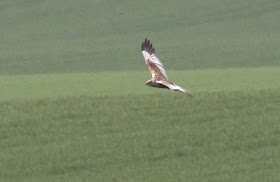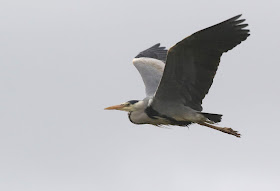On Tuesday we went to Welton Water. It was very misty at first but we had Lesser Whitethroat, Common Whitethroat, Cetti's Warbler, House Sparrow and Goldfinches in the parking area. John P spotted a fox from there too, which went slinking off in a southerly direction.
Common Whitethroat
Lesser Whitethroat
Fox
We went down the first lane and saw plenty of Linnets at first followed by a couple of Whitethroats, and at least 3 Yellowhammers. Unfortunately, this year there was no Grasshopper Warbler, and the Yellow Wagtails were absent.
Yellowhammer
We resumed our walk along the main road to the Humber, and I was surprised to see a male Yellow Wagtail at the top of a distant ash tree. It stayed long enough for everyone to pick out its vibrant colour, and even flew down into the crop before resuming its place in the original tree.
Yellow Wagtail
ditto
A little further on we found a bramble patch containing a rather confiding male Common Whitethroat.
Common Whitethroat
Judy's Grey Lag Goose
We carried on and on reaching the water's edge a Common Sandpiper took to the air and flew right across the water almost from one side to the other. Then Rose spotted a Common Tern on a buoy, which eventually flew towards us, so we all got a decent view. Another one was spotted on a distant buoy.
Common Sandpiper
ditto
ditto
Common Tern
In the afternoon I tried out Leven Canal. There was still no Cuckoo, but there had been an influx of Sedge and Reed Warblers. However, the latter remained hidden from view.
Sedge Warbler
ditto
Green-Veined White
On Wednesday we met at North cave Wetlands and shared cars to North Cliffe Wood. The parking was very limited. It seems the Bluebells were proving popular with non-birdwatchers! Both groups heard a Cuckoo, but the afternoon session managed to see it distantly perched on a dead tree.
Record shot of Cuckoo
Ditto
Cuckoo
Just beyond the heath both groups had a good view of a pair of Garden Warbler with a Willow Warbler in the same area.
Garden Warbler - from Whisby [Monday]
Willow Warbler Bluebells (c) 2019 Maggie Bruce
Hare (c) 2019 Maggie Bruce
Orange-Tip on Bluebells Bluebells (c) 2019 Maggie Bruce
Peacock on Bluebells (c) 2019 Maggie Bruce
Peacock on Bluebells
Hare (c) 2019 Maggie Bruce
Orange-Tip on Bluebells Bluebells (c) 2019 Maggie Bruce
Peacock on Bluebells (c) 2019 Maggie Bruce
Peacock on Bluebells
ditto
Paperthin Peacock (c) 2019 Aileen Urquhart
ditto
ditto
Speckled Wood
We had just over 30 bird species, incl: Garden Warbler, Blackcap, Treecreeper, Willow Warbler, Chiffchaff, Green & Great Spotted Woodpecker (h), Red-legged Partridges, but also Hares, Common Lizard, dancing Long-horned micro moths, Brimstones, Orange-tips, Peacocks, Speckled Woods. Oh, yes, and the Bluebells were at their peak!
Brimstone on Bluebells
Brimstone on a different Bluebell (c) 2019 Maggie Bruce
Brimstone on Bluebells (c) 2019 Aileen Urquhart
Bluebells
Bluebells (c) 2019 Maggie Bruce
A Holly Blue was a nice surprise on the return journey to the cars. Note the silver underside with very few markings - compare with the Common Blue which has many colourful markings on the underside
Holly Blue - silvery underside
Dor Beetle?
Weevil Species
Longhorn Micro-Moths
Green-veined Whites (c) 2019 Tony Robinson
Some of the Wednesday am Group (c) 2019 Aileen Urquhart
Back at the meeting place - Avocet (c) 2019 Symon Fraser
Some of the Wednesday am session went on to Blacktoft Sands, where the following photos of Marsh Harriers were taken...
Marsh Harriers (c) 2019 Tony Robinson
ditto
Marsh Harrier (c) 2019 Tony Robinson
ditto
ditto
ditto
On Thursday the forecast indicated that a visit to the coast would be better than an inland one. Of course this was wrong. It rained in the morning and poured in the afternoon. At least at Tophill Low it was possible to get under cover at crucial moments, until the rain became heavy and constant and it was time to leave.
Goldcrest after a bath
only a few seconds later
There was a Goldcrest in the car park. Both groups stopped off at North Lagoon for the extremely noisy and this time visible large Marsh Frogs. We carried on to South Marsh East, which was the most productive area. Both groups saw a pair of displaying and breeding Little Ringed Plover. There were Common Terns, Shelduck, Gadwall, Tufted Duck, and Oystercatcher visited. A Bar-tailed Godwit was spotted - unfortunately it wasn't brick-red. Meanwhile, a Little Gull was in full summer plumage. Both groups managed fleeting views of a Sedge Warbler.
Marsh Frog
ditto
Marsh Frog (c) 2019 Margaret Richardson
Blackcap
ditto
Predated egg
There were several Great Crested Grebes on O Reservoir, and in the afternoon rain plenty of hirundines and three Swifts!
Common Tern
ditto
ditto
Bar-tailed Godwit [& Lapwing]
ditto
Little Gull
ditto
Ditto
Little Ringed Plovers
ditto
ditto
Drake Pintail
ditto
In the downpour
Female Pintail
Gadwall
Drake Tufted Duck
ditto
The best bird on South Marsh West was a male Linnet supervising his nest-building spouse.
Male Linnet
Male Linnet
Whitethroat
In the morning the group were able to observe a single Whimbrel with 2 Curlews on Watton Nature Reserve, but it didn't remain long, before flying off to the west with the Curlews.
heads of Curlew [left] and Whimbrel
Whimbrel
ditto
ditto
The morning session saw nearly 60 species: summer plumaged Little Gull (SME), Whimbrel (WNR), Bar-tailed Godwit, Goldcrest, Kingfisher, Whitethroat, Lesser Whitethroat, Yellow Wagtail (approach rd), Marsh Harrier, Garden, Sedge, Reed & Willow Warblers, Blackcap, Common Tern, Linnet, Shelduck, Teal, Gadwall, Cormorants, Curlew, Lapwing, Oystercatcher, GC & L Grebe etc.
Orange-Tip
On Friday the weather forecast was for a fine day with a cool northerly wind. Unfortunately, it was drizzling from the start. How do this forecasters manage to get it wrong almost on a daily basis? Luckily, the rain stopped before the morning session started and was only intermittent after that. There was no wind at all at first, and it wasn't too bad by the end of the pm session. In the afternoon it didn't rain at all, even though it looked a little threatening at times.
Short-eared Owl
Carolyn pointed out a bird perched on a distant pole, which turned out to be a Short-eared Owl. Later, both the morning and afternoon group saw two owls hunting for food. They were rivals, as they were often seen in an angry aerial skirmish.
ditto
ditto
ditto
ditto
We came to an area of sheep and their lambs, which was also replete with small birds. These were mainly comprised of Linnets (c.20), Chaffinches, a few Reed Buntings and several Yellowhammers. They were present because this area was absolutely covered with seeding plants. There were Red-Dead Nettles, Spring Beauty, and many groundsel, as well as a species of Cranesbill. This was like a neglected area of the countryside from ye good olde days!
Female Yellowhammer
Linnets
We made it to the reedbed area, and here was the sound of a Cuckoo heard faintly on both sessions. In the afternoon we saw it flying over the fields towards Patrington Haven. This area was ornamented with Warblers including Sedge Warbler, Chiffchaff, Whitethroat, Lesser Whitethroat, Blackcap, Reed Warbler.
Sedge Warbler
John's Wheatear
Both classes saw Marsh Harriers flying over the fields.
Marsh Harrier
ditto
ditto
The morning pupils encountered 42 species with a similar number recorded in the afternoon.
Heron - flew past while I was having lunch
Longhorn Micro-Moth
Emma's Cinnabar Moth
Waders against the Grimsby Tower
Spring Beauty! [not an appropriate name]
Swirling threatening clouds, but no wind!
Both morning and afternoon sessions were very pleasantly surprised by the species we observed in broad daylight in the first week of May. However, this whole area is supposed to be undergoing drastic changes as part of the Flood Realignment Scheme, so it may not be the same another year.







































































































No comments:
Post a Comment